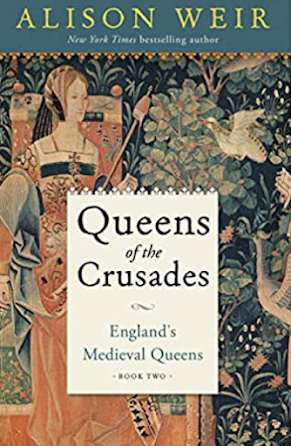Publication Date: February 23, 2021
Length: 560 pages
My Rating: ⭐⭐⭐⭐☆
This book is part two of a three part series on Medieval Queens. Book one deals with the conquest period and book three covers the age of chivalry. I already had purchased this one awhile ago when it was on sale and so that is why I started in the middle. Also, loving the Crusader period, I wanted to learn more about the wives of the Kings involved during this time. Alison Weir is known for being a solid researcher and her books cover her chosen subjects with depth and fidelity so I know I'm getting the facts, not embellished with her opinions.
There are five sections: Eleanor of Aquitaine, Berengaria of Navarre, Isabella of Angouleme, Alienor of Provence, and Eleanor of Castile. Each queen either participated in the Crusades and, or, was Queen during the period of the Crusades. Some had husbands who joined the march to the Holy Land themselves but not all. Of course the most famous of them, Eleanor of Aquitaine, receives the most thorough treatment here but that is common when she is in the mix. I didn't mind because even though I know a lot about her life, there is always some new interesting fact I've not heard before.
The first section on Eleanor of Aquitaine picks up shortly after her meeting of Henry Plantagenet and continues into the next two sections on Berengaria and Isabella. Eleanor's long life meant that she was privy to the lives and marriages of these queens of her sons, Richard and John, and was heavily involved in the politics of the day right up until her last years. It is clear that Weir wants readers to hone in on just how influential she was after her release from captivity with her husband Henry's death and Richard's ascension. The tone of the book suggests just how impressive Eleanor was in her ability to rule when given the opportunity.
When moving from Eleanor to the next three Queens, Weir concentrates more on their husbands. It is clear that there is just not much information on Berengaria, Isabella, or Alienor (Richard I, John, and Henry III's wives) because there was very scant attention to their upbringing and most of the sections focused on minor details such as their charities, religious leanings, and child bearing. I found that I learned much more about the governance of each King and how it affected the country than I did about their spouses but there was still an overall picture of the personalities of each woman: Berengaria presents as a kind, well loved but often neglected lady, Isabella a young naive girl who moved to a more selfish, scheming person in her second marriage to Hugh de Lusignan, and Alienor a devoted mother but often scorned by the country she ruled due to her Savoy relatives.
Eleanor of Castile was given the last section of twelve chapters, almost as much as the first Eleanor, which initially was a surprise. Not knowing much about her I assumed there would not be much more to cover about her than the three previous queens. Accompanying her husband Edward I on the crusades, Eleanor was a formidable woman who was well educated and clearly loved by her devoted spouse. She produced many royal offspring and was beloved by Edward long after her death.
I enjoyed this book and although there were chapters I skimmed through if they focused heavily on details that didn't interest me, overall there was sold, unique information on each queen that I hadn't heard before. I often felt that Weir had little to go on for some of these women and had to stretch some related facts to the point of redundancy and tedium. Unfortunately, for the time this is too common and she had to use what she had and link it to their husbands lives in order to paint a thorough portrait. I plan to eventually read the other two books in the series and they are a great way to get a snapshot of these often forgotten queens of the middle ages.






